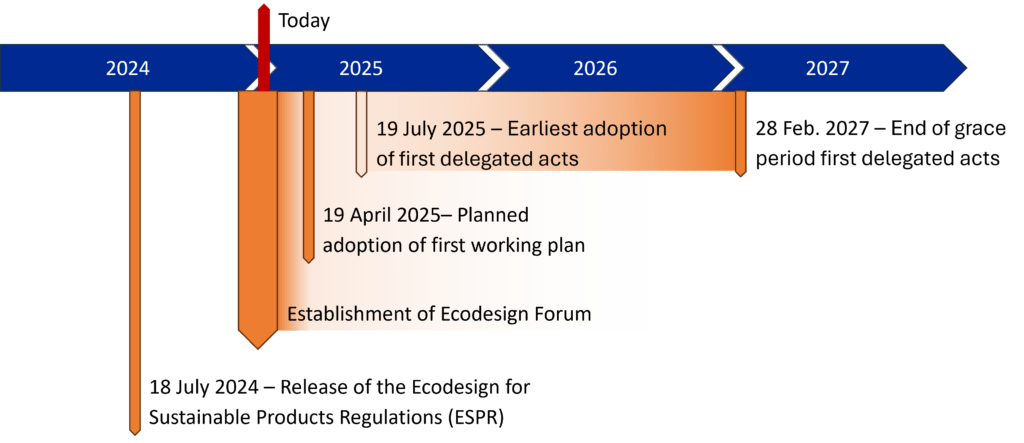Between now and 2030, the European Union plans to introduce the Digital Product Passport (DPP) for key sectors and industries, with significant consequences for consumers and companies both within and outside the Union. But what is the DPP, and what does it aim to achieve?

In December 2019, the President of the European Commission, Ursula von der Leyen, presented the European Green Deal, which set the ambitious target of achieving net-zero greenhouse gas emissions by 2050.
This initiative led to the Circular Economy Action Plan (CEAP) and the Ecodesign for Sustainable Products Regulation (ESPR), aiming to promote ecodesign requirements such as durability, reusability, and repairability, among other criteria.
The Digital Product Passport (DPP) is a tool designed to support the objectives outlined in the CEAP and ESPR. It provides valuable information for customers, such as certificates, manuals, warnings, and how well the product meets the Ecodesign requirements. For manufacturers, elements like the unique product identifier, global trade identification number, and commodity codes hold greater significance. They enable seamless traceability of products and their components throughout the value chain, offering a considerable opportunity for optimisation.
Although the IT infrastructure supporting the DPP will enable product traceability, it is not explicitly required by the Ecodesign for Sustainable Products Regulation (ESPR). The exact content of the passport is defined in product-specific delegated acts, with the first set to be published in the second or third quarter of 2025.
The delegated acts, specified in the ESPR, outline the specific Ecodesign requirements for each product group. The scope of the product groups – whether broad or narrow – is currently unknown but appears to depend on the environmental impact of the product category. For example, batteries are categorised into “batteries and waste batteries”, “electric vehicle batteries”, and “industrial batteries with external storage”.
The delegated acts will also determine the timeline for rule implementation, which Ecodesign requirements must be satisfied, and the specific calculation methods for compliance assessment.
Ecodesign requirements are a set of standards defined by the delegated acts, tailored for specific product groups. Each group has its own set of requirements to which it must adhere. They are designed to improve various product aspects including durability, reliability, energy use and energy efficiency, among others.
Ecodesign requirements can be defined for a smaller group or single products within a product group (vertical Ecodesign requirements) or be relevant to multiple product groups (horizontal Ecodesign requirements). Each requirement will be verifiable, with the European Commission providing tools and methodologies to ensure compliance with the standards.

The ESPR mandates the establishment of the Ecodesign Forum by the Commission, which aims to consult stakeholders on the development process of the regulation. This forum will contribute to the Ecodesign requirements and the working plan, leading to the adoption of the first working plans for prioritised products, followed by the first delegated acts.
Although the adoption of the working plan is scheduled for 19th April 2025 and the release of the first delegated acts for 19th July 2025, Senior Policy Officer Michele Galatola has hinted at a less defined timeline, suggesting that the working plan could be released in the second quarter of 2025 and the delegated acts between the third and fourth quarters. This will also influence the grace period for the affected product groups. The EU Commission expects a full implementation of Digital Product Passports by 2030.

The ESPR specifies an 18-month grace period following the introduction of a delegated act, allowing companies to implement and adapt to the new requirements. The rules are legally binding.
The Ecodesign Forum was established to consult stakeholders on the development of the rules under the ESPR. In this forum, civil society, experts appointed by Member States, industry representatives and academia will contribute to the preparation of Ecodesign requirements and working plans, with the aim of accelerating progress towards reducing the environmental footprint of products.
The product passport is accessed by scanning a data carrier, such as a linear barcode, QR code, 2D data matrix or other types of 2D data carriers. The specific placement of the data carrier – whether at the item, batch, or model level – will be determined in the delegated act. Products with refurbishment or recycling options are more likely to have data carriers at the item level.
While the Commission prefers the data carrier to be placed on the product, it also outlines the possibility of placing them on the packaging or the accompanying documentation.
Transparency and trust
With the DPP, businesses can show their commitment to sustainability and build customer trust by providing transparent and reliable product information.
Efficiency
Access to traceable product and location data reduces inefficiencies and helps companies save time and resources while enhancing operational processes.
Sustainability
By promoting Ecodesign principles such as durability and repairability, the DPP supports business plans for a circular value chain, reducing waste and environmental impact.
Better Supply Chain Management
With product traceability, businesses can monitor their supply chains, optimise logistics and ensure compliance with regulations.

While the exact rules of the ESPR are still evolving, it provides a solid framework for companies to begin preparing. Businesses should focus on identifying key roles for the path to implementation within the organisation. Valuable information can be gathered around data collection procedures, data carrier markings on products and packages, and database management services. Planning for these aspects will lead to a smoother adoption of the Digital Product Passport once the rules are finalised.
Discover our Digital Product Passport Roadmap to help guide implementation in your company.
Products with a Digital Product Passport require a Unique Identifier (UI), such as a serial number or commodity code, and a data carrier, like a QR code or 2D matrix barcode. Ideally, the UI and data carrier remain with the product throughout its lifecycle. This process, known as serialization, serves the purpose of product authentication and regulatory compliance, particularly in industries like pharmaceuticals.
Traceability enables tracking a product throughout its lifecycle. Tracking follows the product from manufacturing to shipment, storage, and distribution. Tracing allows the retrieval of product history, making it essential for verification, audits, and recalls.
Traceability depends on the storage of product data in databases, making product uniqueness essential. Serialization, in turn, acts as a key enabler of traceability.
The Digital Product Passport requires a Unique Identifier and a data carrier, constituting the serialization of products. This ensures that each item can be uniquely identified and tracked throughout its lifecycle.
Although the ESPR does not directly mandate traceability, the objectives outlined in the regulatory framework are difficult to achieve without this technology.
Companies can also leverage traceability along with the supporting IT infrastructure to track and trace products. This provides valuable insights into the flow of goods, which can help businesses optimize their supply chain and enhance operational efficiency.
Vesdo offers decades of experience in serialization management and can provide valuable insights on the full path to serialization, track and trace or traceability. We offer services ranging from single-topic project work to consultations on parts or the entire serialization process and change management.